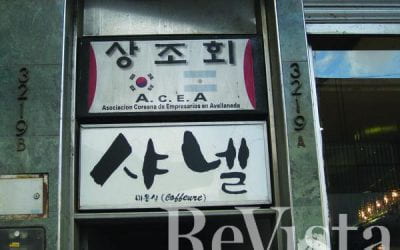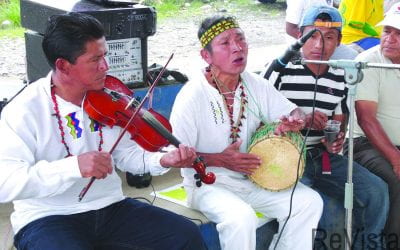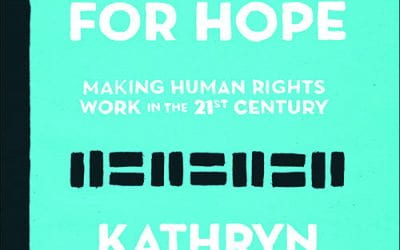Revisiting Circles and Circuits
Chinese migration within the Caribbean began in 1565 with the Spanish Manila galleons, or La Nao de China—which sailed from Manila to Acapulco and created an imagined China within Latin America. The 1800s and early 1900s saw an increase in labor migration tied to the postcolonial legacies of the sugar and tobacco industries, and the construction of railroads and the Panama Canal. Merchants and entrepreneurs also came during this time and together they laid the foundations of Chinese diasporic communities in the Caribbean. These past histories and their legacies have and continue to shape the lives and works of artists in the Caribbean and its diaspora.
The exhibition Circles and Circuits: Chinese Caribbean Art takes on these themes: History and Art of the Chinese Caribbean Diaspora at the California African American Museum (September 15, 2017-February 25, 2018) and Contemporary Chinese Caribbean Art at the Chinese American Museum (September, 15, 2017 – March 22, 2018) as a part of the Getty’s Pacific Standard Time II LA/LA initiative that enabled projects at more than 70 cultural institutions across Southern California to explore Latin American and Latino art in dialogue with Los Angeles.
The title Circles and Circuits references the circles of influence around the artists included in the exhibition, formed by their peers, mentors, and family, while “circuits” alludes to the many migrations, cross-connections, and flows of art, artists, and Chinese diasporic communities—from the Asia/Pacific to the Americas, Africa, the British Commonwealth nations and Europe. The exhibition considered intersections of Asian and African diasporic migrations, Asian coolie (indentured) labor in the Americas, enslavement of Africans in the Americas, and resistance, taking into account how personal relationships and larger contexts of global migrations and historic legacies of cultural, political, and economic power influence and inform artists’ work (above).
While the history of Chinese in the Caribbean may have started with the romantic Spanish Manila galleons, migration really intensified during the mid-late 1800s through the early 1900s. Young Chinese men, especially from Fujian and Guangdong in southern China, signed on as contract laborers or traveled as merchants between China and the Caribbean during this period when China experienced political turmoil due to defeats by the British during the Opium Wars and internal peasant unrest during the Taiping rebellion. Approximately 7.5 million Chinese emigrated globally during the 19th century, with major destinations including Cuba, British West Indies and Panama. The majority of the Chinese who arrived into the West Indies came between 1853 and 1866, after the abolition of the African slave trade necessitated a new source of labor (see Wally Look Lai, Indentured Labor, Caribbean Sugar: Chinese and Indian Migrants to the British West Indies, 1838–1918 (Baltimore: Johns Hopkins University Press, 1993)). Circles and Circuits concentrated on the work of artists who are part of the Chinese Caribbean diaspora in North America, Cuba, Trinidad and Tobago, Jamaica and Panama.
Larger immigrant populations and political, economic, and social-cultural conditions—including the development of national museums and art schools and training abroad—encouraged the development of pipelines of thought with peers in and through major international hubs such as New York, Washington, D.C., London, Paris, Havana, Martinique, Panama City, Kingston and Port of Spain. These streams of movement of people and ideas created transnational networks or “corridors” through which cultural production was nurtured and developed in an interconnected way. Rather than deny the importance and realities of geographic place, and systemic structures of national borders and narratives, the exhibition instead suggests a perspective beyond the physical Caribbean into the spaces of connected local and global communities, affinities and legacies—and likewise expands beyond the idea of derivative art into a corridor of international conversation, exchange and influence.
Circles and Circuits also focused on the postwar period leading up to, through and after Independence movements in the Caribbean in the 1960s, as the impact of creating national identities on artists in the Caribbean became evident in the work of artists and writers, both domestically and in diasporic art circuits abroad. Artists sought primordial “authenticity” and new and old iconographies of nation-building, which looked to their Indigenous and multi-ethnic histories. Their work emerged both as exemplary of and accomplice to the visual complex of nation-building, as well as visual resistance (p. 33). Examples include the work of Sybil Atteck, Carlisle Chang, and others who created and selected national symbols and visual aesthetics of power such as festival design and landscape painting, or Trinidad and Tobago’s national flag and coat of arms. Carlisle Chang designed the coat of arms and national flag for Trinidad after Independence, while Sybil Atteck served on the committee that oversaw the selection of artists and design.
Two female artists from Trinidad, Amy Leong Pang and Sybil Atteck, were fundamental in the development of the artistic communities in Trinidad and Tobago in the 1930s and 1940s. Pang founded the Society of Trinidad Independents, a group of intellectuals and artists from Trinidad and Tobago that published The Beacon, a literary journal that ran between 1931 and 1933 (one final special issue was published in 1939). Many of those involved with The Beacon also shaped the Caribbean Art Movement in London, with artists traveling between Europe and the Caribbean maintaining ties and forming pathways for shared ideas. C. L. R. James, who often wrote for the journal, became a leading figure in Pan-Africanism, and along with George Padmore played an important role in the Caribbean Art Movement involving literature and the arts. Pang was a major force in establishing a homegrown art movement in Trinidad and Tobago, and in teaching, writing and creating artwork for the Trinidad Guardian’s new art section (1939).
From 1945 to 1948 Atteck went to the University of Washington School of Fine Arts in St. Louis, Missouri, and studied under Max Beckmann, who influenced her use of abstraction, angular lines, and color palettes. In 1950 she sailed to London on a British Council scholarship, where she showed her work between 1952 through 1959, including at the Royal Academy and the Commonwealth Institute. Her circle of close friends, among them Boscoe Holder, Nina Squires, and Althea McNish, would also travel to London to continue their careers (fig. 5). Atteck also showed at the São Paulo Biennial, another important international hub, in the mid-1950s and 1960s. She and her students were born from immigrant merchant families, and became heavily involved in defining art education in Trinidad and Tobago and the newly independent nation’s visual and cultural landscape.
The contemporary artists included in Circles and Circuits and presented at the Chinese American Museum in Los Angeles held different viewpoints, and had different relationships with their Chinese Caribbean heritage and positionality within both the Chinese diaspora in the Caribbean and the Chinese Caribbean diaspora that resettled outside the Caribbean. Their works reflect this diversity through the range of intersecting topics they touch upon including: postcolonial histories, personal histories, transcultural aesthetics, gender, sexuality, the body, popular culture, countercultures, food, carnivals, and art history.
One of the artists who was included in both parts of Circles and Circuits is María Magdalena Campos-Pons with her works Finding Balance (2015) and My Mother Told Me I Am Chinese(2008) (p. 31 and 32). During the run of the exhibition, the artist also presented her performance Poetformance at Pico House, a performance space in a historic building across from the Chinese American Museum in Los Angeles.
Her work offers a space for Caribbean identities outside of the more dominant narratives of “black and white.” Her large-scale Polaroid installations triangulate the histories of the slave trade and Chinese coolies in the Caribbean working in the sugar industry, as well as early political meetings and merchant crossings in relation to China, Africa and Europe.
Finding Balance is a part of a larger series of work called FeFa that Campos-Pons and her partner Neil Leonard have installed at both the Havana and Venice Biennale. For Finding Balance, the artist wore a theatrical replica of a Chinese Emperor’s robes, similar to those she saw at the Museum of Archeology in Venice, where she presented 53+1=54+1= 55. Letter of the Year, an installation of birdcages at the Venice Biennale. While at the Biennale, Campos-Pons staged a guerilla performance, walking through the Piazza San Marco wearing the robes and a birdcage on her head, which references a Yoruba headdressas well as an architecture of entrapment that cannot hold onto sound that can drift through its bars.
For FeFa and Finding Balance, the artist also wore sandals purchased in Italy, completing an outfit to echo the presence of merchants from China, Africa, and Europe who historically exchanged wares at the piazza. Similarly, the ceramics of My Mother Told Me I Am Chinese gesture toward crossings with her use of Chinoiserie porcelain wares, famously traded between China and Europe, and were used as religious Santería vessels in Cuba.
Her performance for Circles and Circuits of the work Poetformance stems from her work FeFa. (p.31). A video of dark blue waves was projected as a backdrop as the artist entered the the inner courtyard of Pico House. The building is located in El Pueblo, which serves as the original site of Los Angeles. It is also just blocks away from Union Station, where the old Los Angeles Chinatown was located before it was destroyed to create the station. Pico House is also located one block from what was once known as “Calle de los Negros” and the site of the lynchings of Chinese during the 1871 anti-Chinese massacre.
Wearing a long blue Chinese dress and her hair twisted up, Campos-Pons paced slowly into and around the courtyard, carrying a long sugar cane in her hand, referencing the personal and historic impact of the industry in Cuba. She approached audience members, handing out small gifts and strips of fabric. Crossing the inner courtyard of Pico House, she spoke, repeating the words “If I were a poet” and continued the phrase with narratives about the pain and suffering of passage from one land to another, telling the story of labor, migration, and family histories. With the long sugar cane, she untangled strips of fabric lying on the ground that opened to form the shapes of Chinese pictograms such as door, table, and bed, words of the home. She asked the audience to join with her in remembering and sharing their own stories, passing around a journal for people to add their stories. For Campos-Pons’s FeFa and her related body of work, draws upon circles and circuits, tying together globally interconnected narratives about home, migration, and memory, and finding and redefining the meaning of permanence and locality.
Fall 2018, Volume XVIII, Number 1
Alexandra Chang is the Curator of Special Projects and Director of Global Arts Programs at A/P/A Institute at New York University. An arts scholar and independent curator, she co-organized the Diasporic Asian Art Network. She is the author of Envisioning Diaspora: Asian-American Visual Art Collectives from Godzilla, Godzookie, to the Barnstormers (2008) and the editor of Circles and Circuits: Chinese Caribbean Art (2018).
Related Articles
From Vendedor to Fashion Designer
English + Español
Korean immigrants in Latin America are shaping and developing fashion economies there. Upon arrival, Korean immigrants to Argentina and Brazil may have been lonely, isolated and confused…
Shared Sentiments Inspire New Cultural Centers
English + Español
In the early afternoon of January 3, 2018, in the mountainous village of Shicang, Zhejiang Province, China, firecrackers burst into the air and flags waved in the wind as a parade of Clan…
Evidence for Hope: Making Human Rights Work in the 21st Century
A Review of Evidence for Hope: Making Human Rights Work in the 21st Century Contemporary Human Rights and Latin America On September 5, 1921, Roscoe “Fatty” Arbuckle, Hollywood’s then best-paid star, attended a party in San Francisco’s St. Francis Hotel, drank...










